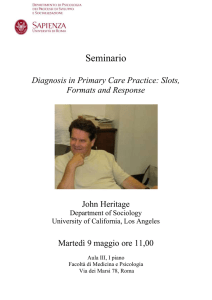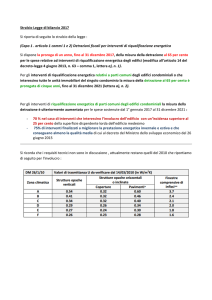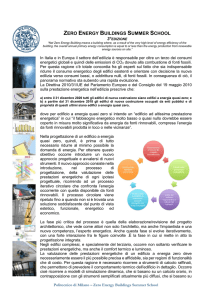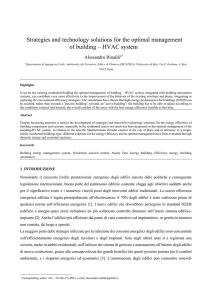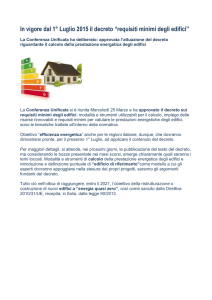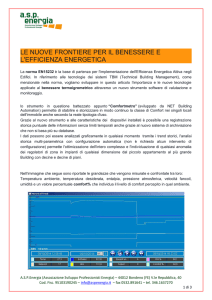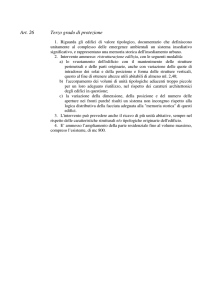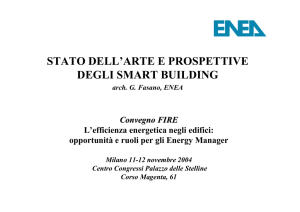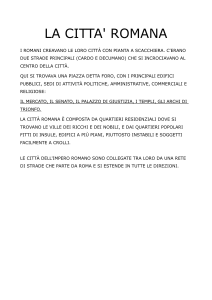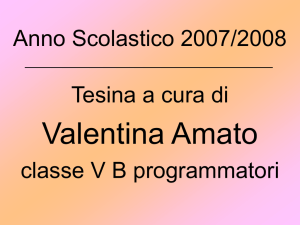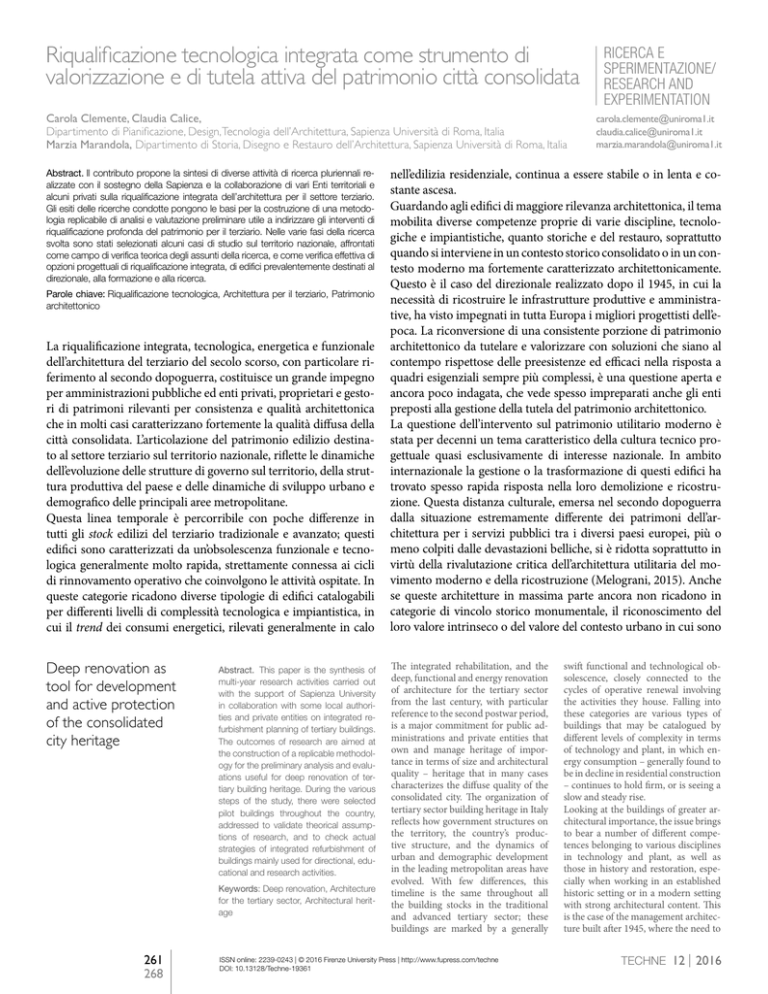
Riqualificazione tecnologica integrata come strumento di
valorizzazione e di tutela attiva del patrimonio città consolidata
Carola Clemente, Claudia Calice,
Dipartimento di Pianificazione, Design, Tecnologia dell’Architettura, Sapienza Università di Roma, Italia
Marzia Marandola, Dipartimento di Storia, Disegno e Restauro dell’Architettura, Sapienza Università di Roma, Italia
Abstract. Il contributo propone la sintesi di diverse attività di ricerca pluriennali realizzate con il sostegno della Sapienza e la collaborazione di vari Enti territoriali e
alcuni privati sulla riqualificazione integrata dell’architettura per il settore terziario.
Gli esiti delle ricerche condotte pongono le basi per la costruzione di una metodologia replicabile di analisi e valutazione preliminare utile a indirizzare gli interventi di
riqualificazione profonda del patrimonio per il terziario. Nelle varie fasi della ricerca
svolta sono stati selezionati alcuni casi di studio sul territorio nazionale, affrontati
come campo di verifica teorica degli assunti della ricerca, e come verifica effettiva di
opzioni progettuali di riqualificazione integrata, di edifici prevalentemente destinati al
direzionale, alla formazione e alla ricerca.
Parole chiave: Riqualificazione tecnologica, Architettura per il terziario, Patrimonio
architettonico
La riqualificazione integrata, tecnologica, energetica e funzionale
dell’architettura del terziario del secolo scorso, con particolare riferimento al secondo dopoguerra, costituisce un grande impegno
per amministrazioni pubbliche ed enti privati, proprietari e gestori di patrimoni rilevanti per consistenza e qualità architettonica
che in molti casi caratterizzano fortemente la qualità diffusa della
città consolidata. L’articolazione del patrimonio edilizio destinato al settore terziario sul territorio nazionale, riflette le dinamiche
dell’evoluzione delle strutture di governo sul territorio, della struttura produttiva del paese e delle dinamiche di sviluppo urbano e
demografico delle principali aree metropolitane.
Questa linea temporale è percorribile con poche differenze in
tutti gli stock edilizi del terziario tradizionale e avanzato; questi
edifici sono caratterizzati da un’obsolescenza funzionale e tecnologica generalmente molto rapida, strettamente connessa ai cicli
di rinnovamento operativo che coinvolgono le attività ospitate. In
queste categorie ricadono diverse tipologie di edifici catalogabili
per differenti livelli di complessità tecnologica e impiantistica, in
cui il trend dei consumi energetici, rilevati generalmente in calo
Deep renovation as
tool for development
and active protection
of the consolidated
city heritage
Abstract. This paper is the synthesis of
multi-year research activities carried out
with the support of Sapienza University
in collaboration with some local authorities and private entities on integrated refurbishment planning of tertiary buildings.
The outcomes of research are aimed at
the construction of a replicable methodology for the preliminary analysis and evaluations useful for deep renovation of tertiary building heritage. During the various
steps of the study, there were selected
pilot buildings throughout the country,
addressed to validate theorical assumptions of research, and to check actual
strategies of integrated refurbishment of
buildings mainly used for directional, educational and research activities.
Keywords: Deep renovation, Architecture
for the tertiary sector, Architectural heritage
261
268
RICERCA E
SPERIMENTAZIONE/
RESEARCH AND
EXPERIMENTATION
[email protected]
[email protected]
[email protected]
nell’edilizia residenziale, continua a essere stabile o in lenta e costante ascesa.
Guardando agli edifici di maggiore rilevanza architettonica, il tema
mobilita diverse competenze proprie di varie discipline, tecnologiche e impiantistiche, quanto storiche e del restauro, soprattutto
quando si interviene in un contesto storico consolidato o in un contesto moderno ma fortemente caratterizzato architettonicamente.
Questo è il caso del direzionale realizzato dopo il 1945, in cui la
necessità di ricostruire le infrastrutture produttive e amministrative, ha visto impegnati in tutta Europa i migliori progettisti dell’epoca. La riconversione di una consistente porzione di patrimonio
architettonico da tutelare e valorizzare con soluzioni che siano al
contempo rispettose delle preesistenze ed efficaci nella risposta a
quadri esigenziali sempre più complessi, è una questione aperta e
ancora poco indagata, che vede spesso impreparati anche gli enti
preposti alla gestione della tutela del patrimonio architettonico.
La questione dell’intervento sul patrimonio utilitario moderno è
stata per decenni un tema caratteristico della cultura tecnico progettuale quasi esclusivamente di interesse nazionale. In ambito
internazionale la gestione o la trasformazione di questi edifici ha
trovato spesso rapida risposta nella loro demolizione e ricostruzione. Questa distanza culturale, emersa nel secondo dopoguerra
dalla situazione estremamente differente dei patrimoni dell’architettura per i servizi pubblici tra i diversi paesi europei, più o
meno colpiti dalle devastazioni belliche, si è ridotta soprattutto in
virtù della rivalutazione critica dell’architettura utilitaria del movimento moderno e della ricostruzione (Melograni, 2015). Anche
se queste architetture in massima parte ancora non ricadono in
categorie di vincolo storico monumentale, il riconoscimento del
loro valore intrinseco o del valore del contesto urbano in cui sono
The integrated rehabilitation, and the
deep, functional and energy renovation
of architecture for the tertiary sector
from the last century, with particular
reference to the second postwar period,
is a major commitment for public administrations and private entities that
own and manage heritage of importance in terms of size and architectural
quality – heritage that in many cases
characterizes the diffuse quality of the
consolidated city. The organization of
tertiary sector building heritage in Italy
reflects how government structures on
the territory, the country’s productive structure, and the dynamics of
urban and demographic development
in the leading metropolitan areas have
evolved. With few differences, this
timeline is the same throughout all
the building stocks in the traditional
and advanced tertiary sector; these
buildings are marked by a generally
ISSN online: 2239-0243 | © 2016 Firenze University Press | http://www.fupress.com/techne
DOI: 10.13128/Techne-19361
swift functional and technological obsolescence, closely connected to the
cycles of operative renewal involving
the activities they house. Falling into
these categories are various types of
buildings that may be catalogued by
different levels of complexity in terms
of technology and plant, in which energy consumption – generally found to
be in decline in residential construction
– continues to hold firm, or is seeing a
slow and steady rise.
Looking at the buildings of greater architectural importance, the issue brings
to bear a number of different competences belonging to various disciplines
in technology and plant, as well as
those in history and restoration, especially when working in an established
historic setting or in a modern setting
with strong architectural content. This
is the case of the management architecture built after 1945, where the need to
TECHNE 12 2016
01 | Hotel de Ville di Le Havre, progetto di Auguste Perret
(1953-58) [foto di F. Bandarin, © UNESCO]
Hotel de Ville in Le Havre, Auguste Perret designed by
(1953-58) [photo by F. Bandarin © UNESCO]
radicate ha portato a una nuova sensibilità nella loro gestione. In
molti casi manca ancora una consolidata capacità critica di progetto per questa categoria di edifici, in modo particolare verso le
architetture della ricostruzione, realizzate tra il 1945 e i primi anni
Sessanta. Questi edifici, quando riescono a conservare la loro integrità morfologica, sono spesso fortemente modificati negli spazi
interni, nelle finiture e negli apparati decorativi, elementi in alcuni
casi parte integrante del progetto e della sua qualità architettonica.
Questi immobili sono stati a lungo considerati, tolte pochissime
eccezioni, semplici contenitori di utilità e come tali sono stati vissuti, gestiti e molto spesso maltrattati.
Parte della responsabilità di questo modus operandi è da ricondurre alla mancanza di una cultura «del “progetto per il costruito
esistente”, luogo come fu delimitato dalla ricerca tecnologica come
territorio di scambio tra la manutenzione edilizia e il restauro»
(Fontana, 2013). La storicizzazione di questi manufatti, concepiti
come manifesto di modernizzazione di un paese e delle sue strutture di servizio, ha permesso di aprire una nuova linea di intervento più consapevole, ma ancora non completamente matura. Ci si
rivolge a questi edifici con i protocolli della disciplina del restauro,
considerando come qualificazione del manufatto esclusivamente
il ripristino della sua immagine originale, senza intervenire sulle
prestazioni tecnologiche del sistema edilizio. Questo tipo di atteggiamento estremamente conservativo si dimostra mortificante
dello spirito progettuale originale, per contro in alcuni contesti è
stato ritenuto indispensabile per la conservazione dell’immagine
architettonica, fortemente caratterizzata dalle tecnologie impiegate in origine.
Esistono alcuni esempi meritevoli di nota per l’ampiezza e per la
caratterizzazione degli interventi, come la lunga e articolata opera
reconstruct the productive and administration infrastructure engaged the
period’s finest designers throughout
Europe. The conversion of a considerable portion of architectural heritage
to be protected and capitalized on with
solutions that both respect pre-existing
buildings and are effective in their
response to increasingly complex requirement frameworks is an open and
still under-examined question; often,
even the entities in charge of managing
the protection of architectural heritage
find themselves unprepared.
For decades, the question of intervening in the modern utilitarian heritage
has been a characteristic theme of technical design culture almost exclusively
of national interest. In the international
sphere, the management or transformation of these buildings has often found
a quick response in their demolition or
reconstruction. This cultural distance –
262
which emerged in the second postwar
period from the extremely different
situation of architectural heritage for
public services among the various European countries more or less stricken
by the devastations of war – narrowed,
especially by virtue of the modern and
reconstruction movement’s critical reevaluation of utilitarian architecture
(Melograni, 2015). Although these
architectures, to a great degree, have
yet to come under categories of monumental landmarking, the recognition
of their intrinsic value, or of the value
of the urban context they are rooted in,
has brought about a new sensitivity in
their management. In many cases, no
critical design ability for this category
of buildings has yet been established,
particularly for the reconstruction architectures built between 1945 and the
early 1960s. These buildings, when they
manage to conserve their morphologi-
01|
di riqualificazione e restauro del centro di Le Havre, ricostruito
a partire dal 1946 su progetto di Auguste Perret, sito iscritto nel
2005 dall’UNESCO nel patrimonio dell’umanità1. In questo caso
tutti gli edifici concepiti nel piano originale sono stati sottoposti
a restauro, senza modificare né la qualità architettonica delle finiture, né le tecnologie costruttive utilizzate e le prestazioni del
sistema edificio-impianto (Fig. 1). Più spesso purtroppo molti tra
gli edifici utilitari, privi di particolari valori storico-testimoniali o
simbolici, hanno subito rifacimenti massicci e poco rispettosi del
disegno originale.
Si stanno moltiplicando occasioni progettuali in cui conservazione dell’immaginario storico urbano, riqualificazione operativa e
deep renovation trovano una giusta conciliazione laddove viene
richiesto un investimento progettuale in cui innovazione funzionale e tecnologica sostengono la valorizzazione dell’immagine architettonica. Questo è il caso del concorso internazionale per il
rinnovo della Tour Montparnasse2, bandito nella primavera del
2016, che sempre a Parigi segue il felice esempio della riqualificazione in corso del Campus di Jussieu3 che ha visto impegnati
cal integrity, are often highly modified
in their interior spaces, in their finishings, and in their decorative apparatus
– elements in some cases integral to
the design and its architectural quality. These buildings were, with very few
exceptions, long considered mere containers of utility, and were experienced,
managed, and often mistreated as such.
Part of the responsibility for this modus
operandi may be laid upon the lack of
a culture of “of the ‘design for the existing building,’ a place delimited by
technological research as the ground
for exchange between building maintenance and restoration” (Fontana,
2013). The historization of these buildings, conceived as a manifesto of modernization of a country and of its service structures, has made it possible to
open up a new line of intervention that,
although more aware, has yet to fully
mature. We address these buildings
C. Clemente, C. Calice, M. Marandola
with the protocols of the discipline of
restoration, considering refurbishment
exclusively as restoring the building’s
original appearance, without intervening in the building system’s technological performance. Although this kind
of highly conservative attitude ends
up demeaning the original spirit of the
design, on the other hand, in certain
contexts, it was deemed indispensable
for preserving the architectural image
strongly characterized by the technologies originally used.
Some instances of this way of operating are noteworthy for the breadth and
the very nature of the interventions;
one example is the long and complex
refurbishment and restoration of the
Le Havre centre, rebuilt starting in
1946 to a design by Auguste Perret, and
named a UNESCO World Heritage Site
in 20051. In this case, all the buildings
conceived in the original plan were
TECHNE 12 2016
02 | Campus Jussieu a Parigi, intervento di riqualificazione del Settore Est, A.S. Architecture
Studio (2008-15) [foto di Architecture-Studio, A.Duhamel]
Jussieu Campus in Paris, renovation of the East Sector, A.S. Architecture Studio (2008-15)
[photo by Architecture-Studio, A.Duhamel]
03 | Campus Jussieu a Parigi, intervento di riqualificazione del Settore Est, A.S. Architecture
Studio (2008-15) [foto di Architecture-Studio, L. Boegly]
Campus Jussieu in Paris, renovation of the East Sector, A.S. Architecture Studio (2008-15)
[photo by Architecture-Studio, L. Boegly]
diversi gruppi di progettazione e la struttura di committenza in
un’articolata operazione di bonifica ambientale, di recladding e di
riorganizzazione funzionale del principale campus urbano della
città (Fig. 2, Fig. 3).
Questi interventi, rilevanti per dimensione e qualità degli operatori
coinvolti, rappresentano delle occasioni di sperimentazione esemplare su un tema ancora lontano dall’essere sistematizzato. La conoscenza di questo patrimonio, articolato per tipologia edilizia, destinazione d’uso e tecnologie costruttive impiegate, è ancora molto
disorganica e mancano dati aggregati validi. La frammentarietà dello stato dell’arte è dovuta in parte alla estrema parcellizzazione della
tipologia di proprietà, della enorme differenza di modelli gestionali
tra il terziario pubblico e il terziario privato, che, oltre a essere articolato per funzione ospitata, spesso vede una netta separazione tra
proprietà, ente gestore e utilizzatore finale dell’edificio. La caratterizzazione del patrimonio è tra le ragioni per cui, nonostante le forti
sollecitazioni comunitarie4, sulla riqualificazione del terziario non
esistono ancora dati sistematizzati, né a livello nazionale né europeo,
se non stime previsionali di impatto sulla potenzialità degli interventi di efficientamento energetico del settore nel medio periodo,
che al momento sembra essere l’unica leva potenziale per promuovere una sistematizzazione degli studi sul tema (Carbonara, 2015).
Il dibattito aperto sull’efficienza energetica nel settore terziario tradizionale e ad alta complessità tecnologica si è sviluppato dagli anni
Novanta senza però condurre a una strategia efficace di intervento e
riconversione tecnologica ed energetica del patrimonio.
La terziarizzazione del sistema produttivo e le conseguenti trasformazioni edilizie poco attente all’uso razionale della risorsa edificio
avvenute negli ultimi decenni, hanno portato a un impoverimento qualitativo dello stato del patrimonio e alla crescita costante dal
1990 a oggi dei consumi del settore terziario, unico settore a registrare +105% dal 1990 al 2012, incremento scoraggiante se rapportato all’obiettivo nazionale per il 2020, raggiunto, con il risparmio
di energia finale conseguito negli anni 2011-2013, per solo il 5,6 %,
subjected to restoration, without modifying the architectural quality of the
finishings, the construction technologies used, or the performance of the
building/plant system (Fig. 1). Unfortunately, more often, many of the utilitarian buildings, with no particular historical, testimonial, or symbolic values,
have undergone massive renovations
showing little respect for the original
design.
There are more and more design opportunities appropriately reconciling
preservation of the historic urban image, operative refurbishment, and deep
renovation; these require a design investment in which functional and technological innovation uphold the architectural image. This is the case with the
international competition for the renovation of Tour Montparnasse2, held in
the spring of 2016, which followed the
successful example of refurbishment
the private one which – in addition to
being broken down by the function
housed there – is often marked by a
clear separation between the building’s ownership, management, and end
user. The characterization of the heritage is among the reasons why, in spite
of strong EU urging4, systematized
data on the refurbishment of tertiary
architecture are still lacking on both
the national and European levels, except for forecast estimates of impact
on the potential of the sector’s energy
efficiency efforts in the medium term;
at the moment, this appears to be the
only potential lever for promoting a
systematization of studies on the issue
(Carbonara, 2015). The open debate
on energy efficiency in the traditional
tertiary and high-tech sector has developed since the 1990s, but without
conducting an effective strategy for
intervention and for the technological
02|
03 |
263
underway of the Jussieu Campus3, also
in Paris – a project that has involved
various design groups and the commissioning parties in a complex operation
of environmental restoration, recladding, and functional reorganization of
the city’s main urban campus (Fig. 2,
Fig. 3).
These interventions, of importance for
the size and quality of the operators
involved, present opportunities for experimentation on an issue still far from
being systematized. Knowledge of this
heritage, organized by building type,
intended use, and construction technologies employed, is still very much in
flux, and lacks sound, aggregated data.
The fragmentary nature of the state of
the art is due in part to the extreme
compartmentalization of the types of
ownership, and of the enormous difference of management models between the public tertiary sector and
C. Clemente, C. Calice, M. Marandola
and energy conversion of heritage. The
difficulty of classifying the common
traits of the building stock to be analyzed translates into a low capacity for
action, due also to the dearth of effective guidelines in support of design for
existing architecture.
The tertiarization of the productive
system, and the consequent building
transformations inattentive to the rational use of the building resource that
have occurred in recent decades, has
impoverished the quality of the state of
the heritage, and has resulted in steadily growing consumption, from 1990
to the present time, in the tertiary sector – the only sector that, from 1990 to
2012, saw a +105% increase. This is a
discouraging rise when compared to
the national objective for 2020, which,
with the final energy savings achieved
in 2011-2013, was only 5.6% accomplished, against 35.2% in the residential
TECHNE 12 2016
contro il 35,2% del settore residenziale ed il 26,6% dell’industria
(ENEA, 2015). La combinazione di questi fattori ha portato al deprezzamento di alcuni segmenti degli asset esistenti, fattore apparentemente ritenuto congiunturale, ma in realtà strettamente connesso
allo stato di inefficienza tecnologica degli edifici. Un patrimonio di
0,7 milioni di edifici, pari a 3,4 milioni di unità immobiliari per una
superficie di 0,85 miliardi di metri quadri che viene riconvertito a
ritmi eccessivamente lenti e poco strutturati (CRESME, 2014), dove
le uniche dinamiche di riduzione dei consumi sono state accertate
per la contrazione produttiva dovuta al perdurare della stagnazione
economica degli ultimi anni. Dal 2013 a oggi, si è di fatto registrata una lieve inversione di tendenza nei consumi anche nel settore
terziario, in parte dovute alla riduzione di produttività del settore,
in parte agli effetti dei primi interventi di riqualificazione portati a
termine, soprattutto su edifici per la formazione.
In particolare il patrimonio nazionale destinato al direzionale, pari
a circa 88,09 milioni di metri quadri ha un consumo specifico stimato di 114 kWh/mq, un valore troppo alto e allineato o superiore
ai livelli di consumo di altri comparti del patrimonio sui quali si sta
intervenendo in maniera più strutturata e incisiva, come nel caso
del patrimonio residenziale e scolastico.
La tipologia del direzionale qui indagato è una specificità italiana,
si tratta infatti di un edificio a blocco, a media o alta densità, che si
inserisce spesso nel tessuto dell’espansione postunitaria ottocentesca, riprendendo quasi integralmente il perimetro dell’isolato
del tessuto su cui insiste, in qualche caso riproponendo anche le
proporzioni dell’edificato a cui si sostituisce. Si verifica la densificazione del tessuto della periferia storica consolidata, ormai
assorbita dalla città moderna in espansione dove l’insediamento
a bassa densità, caratterizzato dal villino signorile o dalla piccola
sector and 26.6% for industry (ENEA,
2015). Taken together, these factors
have brought about the depreciation of
certain segments of the existing assets,
a factor apparently believed connected
with the current economic situation,
but actually closely linked to the buildings’ state of technological inefficiency.
In this heritage of 0.7 million buildings,
equal to 3.4 million real estate units for
an area covering 0.85 billion square
metres, that is being converted at excessively slow and poorly structured
rates (CRESME, 2014), the only consumption-reducing dynamics came
with the diminished production owing
to the continuing economic stagnation
in recent years. Since 2013, consumption trends have actually seen a slight
reversal in the tertiary sector as well,
due in part to the sector’s lower productivity, and in part to the effects of
the first refurbishments that have been
264
completed, especially on education
buildings. In particular, the national
heritage for management facilities,
equal to approximately 88.09 million
square metres, has an estimated specific consumption of 114 kWh/m2 – an
excessively high figure in line with or
outstripping the consumption levels of
other sectors of the heritage on which
more structured and incisive action has
been taken, as in the case of residential
and school heritage.
The building for the service sector
type discussed here is specific to Italy:
a building block, of medium or high
density, often included in the fabric of
post-Unification nineteenth-century
expansion, almost fully occupying
the perimeter of the city block in the
fabric it stands on, and in some cases
also replicating the proportions of the
buildings it has replaced. The fabric of
the established historic periphery has
abitazione collettiva, viene trasformato in terziario direzionale,
amministrativo o commerciale, generalmente occupato da una
singola attività. Questa tipologia, molto diffusa sul territorio nazionale, è poco praticata nel resto d’Europa dove, soprattutto nelle aree metropolitane, prevale l’edificio alto, con densità edilizie
maggiori e maggiori concentrazioni di attività diverse tra di loro,
dove proprietario e utilizzatore finale degli spazi non coincidono,
se non nel caso del direzionale pubblico o istituzionale. Poche
sono le eccezioni tipologiche sul territorio italiano, che troviamo
concentrate in area milanese e nel quartiere dell’EUR a Roma,
che dopo la pausa bellica riprende il suo sviluppo immobiliare in
modo intenso a partire dalla fine degli anni Cinquanta5.
Si moltiplicano gli strumenti di incentivazione per la riqualificazione e la gestione energetica, sostenuti da fondi europei e
programmi operativi Por Fesr 2014-2020. Tra questi il D.Lgs
102/20146, in attuazione della direttiva 2012/27/UE che introduce un programma di miglioramento della prestazione energetica
della pubblica amministrazione centrale e l’obbligo per le grandi
imprese di dotarsi di diagnosi energetica, secondo criteri di qualità e affidabilità, e di sistemi di monitoraggio dei flussi energetici. L’adozione di sistemi di monitoraggio consente la definizione
della baseline e del breakdown energetico d’impresa estremamente realistico e preciso, con l’obiettivo di massimizzare l’efficacia
di interventi di riqualificazione. Tali strumenti, tuttavia, con riescono a far leva su un know-how diffuso, che possa confortare gli
utenti finali che ancora percepiscono gli interventi da mettere in
campo troppo complessi e poco efficaci nel ritorno economico
dell’investimento.
La cogenza normativa è fondamentale in un contesto tecnico e
decisionale ancora non sufficientemente informato e attento, sia
grown denser; this periphery is now
absorbed by the modern, expanding
city where low-density settlement,
characterized by the stately villa or the
small collective home, is transformed
into management, administrative, or
commercial architecture, generally occupied by a single activity. This type,
highly widespread throughout Italy, is
unpopular elsewhere in Europe where,
especially in the metropolitan areas, tall buildings prevail, with greater
construction densities and greater
concentrations of activities different
from one another; here, the owner and
the end user of the spaces do not coincide, except in the case of public or
institutional management architecture.
There are few exceptions in Italy, found
concentrated in the Milan area and in
Rome’s EUR neighbourhood where,
after the interruption of the War, realestate development came roaring back
C. Clemente, C. Calice, M. Marandola
in the late 1950s5. Supported by European funds and by Por Fesr 2014-2020
operative programmes, incentivize instruments for energy management and
renovation have multiplied. These include Legislative Decree no. 102/20146,
implementing Directive 2012/27/EU
which introduces a programme to
improve the energy performance of
public bodies’ buildings and the obligation for large enterprises to adopt
energy diagnosis, in accordance with
criteria of quality and reliability, and
energy flow monitoring systems. The
adoption of monitoring systems makes
it possible to establish a highly realistic
and precise baseline and breakdown
of business energy, with the aim of
maximizing the effectiveness of refurbishments. However, these instruments cannot depend on a widespread
know-how of comfort to the end users,
who still perceive the interventions to
TECHNE 12 2016
04 | Città universitaria de “la Sapienza”
Campus de “La Sapienza”
05 | Edificio per uffici ex SIAE in Via Gianturco a Roma ora sede della Facoltà di Architettura
de “la Sapienza” progetto L. Passarelli, V. Monaco, A. Luccichenti, J. Lafuente (1955-56)
Office building in Via Gianturco ex SIAE in Rome now Sapienza Faculty of Architecture
designed by L. Passarelli, V. Monaco, A. Luccichenti, J. Lafuente (1955-56)
per il settore pubblico cui spetta il ruolo di modello e di promotore di best-practice nella gestione del proprio patrimonio, che
per il settore privato che fatica a trovare attrattività in investimenti al di fuori del proprio core business, anche quando questi comportano un consistente utile dal risparmio sulla bolletta
energetica e un incremento della qualità dei luoghi di lavoro.
Oltre agli strumenti di indirizzo normativo sul settore terziario, l’adozione di alcuni comportamenti virtuosi come di ECM
(Energy Conservation Measures)7, diffusi a partire dai primi
anni Duemila negli Stati Uniti (ASHRAE, 2002), concorre a migliorale il livello di consapevolezza diffusa tra tecnici, gestori e
utenti finali della necessità di governare trasformazioni tecnologiche, dispositivi tecnici e comportamenti d’uso.
L’adozione di ECM nel settore terziario necessita di strategie di
indirizzo, basate sulla creazione di banche dati estese e diversificate, attualmente non disponibili, contenenti i dati necessari per
la caratterizzazione degli edifici e del relativo audit e per la definizione di modelli del tipo falling rule list, ovvero linee di indirizzo con probabilità di efficacia dell’investimento decrescente, che
permettano di definire, anche con attività di auditing speditive,
analisi costi-benefici e ricadute non quantificabili, quali la trasformazione di edifici in ambito storico consolidato o moderno,
ma fortemente caratterizzato.
Le ricerche svolte di cui riportiamo parte dei risultati, mirano
proprio alla modellizzazione degli edifici pilota utili alla parametrizzazione delle analisi e dei risultati attesi, e hanno avuto
come oggetto di approfondimento iniziale il patrimonio edilizio
della Sapienza8, dal suo nucleo storico monumentale (1932-35)
agli edifici più recenti. Lo studio rivolto a definire le modalità
di intervento sul patrimonio terziario di pregio destinato alla
be implemented as too complex and
ineffective in terms of return on investment. Regulatory constraint is essential
in a technical and decision-making
setting that has yet to be sufficiently
informed and attentive, both for the
public sector tasked with the role of
being a model and promoter of best
practises in managing its heritage, and
for the private sector that labours to
find attractiveness in investments outside its own core business – even when
these investments bring considerable
profits derived from savings on energy
bills and from the higher quality of the
workplaces.
Beyond the instruments of regulatory guidance on the tertiary sector,
the adoption of certain virtuous behaviours like ECMs (Energy Conservation Measures)7, which spread in the
United States starting in the early 2000s
(ASHRAE, 2002), helps raise aware-
265
04 |
formazione e alla ricerca ha permesso di codificare una metodologia di indagine integrata dal punto di vista storico, tecnologico, strutturale e impiantistico che potesse essere replicabile
su altri stock edilizi9. Il patrimonio della Sapienza si è rivelato un
campione ricco per complessità e qualità tecnico costruttiva, con
ottime potenzialità di riqualificazione funzionale e prestazionale,
soprattutto nella sua parte storica, dove le tecnologie costruttive
d’involucro hanno dimostrato di possedere prestazioni fisico tecniche e di durabilità relativamente buone, con ottime possibilità
di implementazione prestazionale attraverso interventi poco invasivi (Fig. 4). Di tutt’altro tipo sono stati i risultati sugli edifici
realizzati a partire dagli anni Sessanta dove la risposta prestazionale, soprattutto delle componenti di involucro e dei sistemi
impiantistici, si è dimostrata non più in linea né con le esigenze
d’uso delle funzioni ospitate né tanto meno per le specifiche di
prestazioni offerte, molto distanti dagli standard prestazionali
attuali in termini di comfort acustico, visivo-attenzionale e di requisiti energetici (Fig. 5).
ness, among technicians, operators and
end users, of the need to govern technological transformations, technical
devices, and use behaviours.
Adopting ECMs in the tertiary sector
requires guidance strategies based on
the creation of extended and diversified databases – currently not available
– containing the data needed to characterize buildings and their auditing, and
to define “falling rule lists”; these are
guidelines, with decreasing likelihood
of the investment being effective, that
make it possible – also with expeditious
auditing activities – to define costbenefit analyses and unquantifiable
impacts, such as the transformation of
buildings in an established or modern
but highly characterized historical environment.
To form this database, it is essential to
identify some highly significant pilot
cases; studying these buildings is indis-
C. Clemente, C. Calice, M. Marandola
05 |
TECHNE 12 2016
06 | Istituto di Chimica Farmaceutica Città Universitaria de “la Sapienza” (1956 - 62)
progetto architetti M. Boschetti, L. Giovannini, M. Battaglini e M. Lombardi
Institute of Pharmaceutical Chemistry, Sapienza Campus (1956-62) designed by
M. Boschetti, L. Giovannini, M. Battaglini and M. Lombardi
Il caso dell’edificio di Chimica Farmaceutica (Fig. 6), realizzato
dal 1962 al 1966, è rappresentativo sotto il profilo tecnologico e
prestazionale e ha potuto condurre, attraverso la modellazione
energetica in regime dinamico, all’identificazione dei margini
di miglioramento. Con la simulazione progettuale di interventi sinergici sul sistema involucro-impianti (miglioramento prestazionale involucro, ripensamento completo del sistema delle
schermature solari, installazione di sistemi di controllo dei parametri ambientali, impianti di climatizzazione multisplit e introduzione di rinnovabili) si è ottenuta una riduzione del 78%
sull’indice di prestazione energetica in kWh/mc anno (da 68
kWh/mc anno a 10,5 kWh/mc anno), e del 40% delle emissioni
climalteranti.
Gli studi svolti hanno premesso di codificare una modalità di
intervento, testata successivamente su gruppi di edifici ritenuti
esemplari per tipologia, consistenza e periodo di realizzazione,
concentrando le analisi sugli edifici successivi al 1945. Le analisi
e le simulazioni svolte hanno portato a determinare la necessità
di prevedere una riqualificazione pesante delle componenti di
involucro e del sistema della gestione del comfort interno, non
tanto per le non ottimali condizioni di manutenzione degli edifici quanto per l’incompatibilità dei quadri esigenziali attuali con
quelli di progetto.
È stato riscontrato che, quand’anche le componenti di involucro
avessero ancora delle prestazioni residuali discrete, le condizioni
di utilizzo degli spazi, di gestione del lavoro della sicurezza degli utenti non erano più compatibili con le prestazioni originali
dell’edificio. Edifici, in origine luogo di sperimentazioni tecnologiche, tipologiche e costruttive avanzate per l’epoca, non hanno
retto alla prova del tempo e di un utilizzo spesso poco accorto. Il
cattivo utilizzo dei componenti di involucro o di alcuni dispositivi di controllo ambientale, come schermature mobili, sistemi di
aperture differenziati o dispositivi per la ventilazione naturale, ha
compromesso la stabilità geometrica e la tenuta delle componenti
di involucro intaccando l’efficienza del sistema edificio/impianto.
Interventi di manutenzione messi in atto senza nessun controllo
o regia tecnica hanno ulteriormente aggravato il quadro generale
di obsolescenza del sistema di prestazioni dell’edificio fino a privarlo anche della sua qualità morfologica d’insieme.
Nella città di Roma gli edifici selezionati per tipologia, localizzazione, epoca di costruzione, destinazione d’uso attuale, che
avessero caratteristiche affini al modello descritto in precedenza,
sono stati analizzati dal punto di vista storico, per individuare i
caratteri architettonici e costruttivi salienti, da recuperare o da risarcire; di questi edifici è stato ricostruito il modello d’uso attuale
e le vicende legate all’evoluzione dell’attività contenuta. Sono state
svolte tutte le verifiche di congruenza dei requisiti attivi e passivi dell’edificio in termini di sicurezza, prestazione strutturale,
comfort ambientale e ne sono stati modellizzati consumi e carichi
energetici. In quest’ottica la riqualificazione energetica e funzio-
pensable for the integrated investigation of this portion of heritage.
The research that has been carried out,
a portion of whose results are reported,
aim precisely at modelling the pilot
cases of use for the parametrization of
the analyses and of the expected results,
and regarded the initial examination of
the building heritage of Rome’s Sapienza University8, from its monumental
historic nucleus (1932-35) to the most
recent buildings. Aimed at establishing
the modes of intervention on prized
tertiary heritage designed for education
and research, the study made it possible
to codify an investigation methodology, integrated from the standpoint of
technology, structure, and plant, that
might be replicable on other building
stocks9. Sapienza University’s heritage
proved to be a rich sample, given its
complexity and technical/constructive
quality, with outstanding potential for
(Fig. 6) built from 1962 to 1966 is representative in terms of technology and
performance, and was able, through
dynamic energy modelling, to identify
margins for improvement. The design
simulation of synergic interventions
on the envelope/plant system (performance improvement of the envelope,
a complete reconceiving of the solar
shading system, installation of systems
to control environmental parameters,
multisplit climatization system and the
introduction of renewables) brought
about a 78% reduction in the energy
performance index in terms of kWh/
m3 year (from 68 kWh/m3 year to 10.5
kWh/m3 year), and a 40% decline in
climate-changing emissions.
The studies that were done have made
it possible to codify an intervention
procedure, later tested on groups of
buildings deemed exemplary by type,
size, and period of construction, with
06 |
266
renovated function and performance
(especially in its historic part, where the
envelope’s construction technologies
have been shown to possess relatively
good physical/technical and durability
performance), and with excellent possibilities for performance implementation by means of minimally invasive
interventions (Fig. 4). The results on
the buildings constructed starting in
the 1960s are of a wholly different kind.
In these buildings, the performance
response, especially of the envelope
components and the plant systems,
proved to be no longer in line with the
use requirements of the housed functions – all the less given the offered
performance specifications, which are
quite distant from current performance
standards in terms of acoustic and
visual-attentional comfort, and energy
requirements (Fig. 5). The case of the
Pharmaceutical Chemistry building
C. Clemente, C. Calice, M. Marandola
analyses concentrating on post-1945
buildings. The analyses and simulations led to determining the need to
perform a deep renovation of the envelope components and of the interior comfort management system, not
so much because of the non-optimal
conditions of building maintenance,
but because of the current requirement
frameworks’ incompatibility with the
design frameworks.
It was found that even when the envelope components still had fair residual
performance, the conditions of use of
the spaces, and of managing the work
for the users’ safety, were no longer
compatible with the building’s original
performance. These buildings – originally places of technological, typological, and construction experimentation
efforts that were ahead of their time –
have not withstood the test of time and
of a use that was often ill-advised. The
TECHNE 12 2016
nale dell’edificio è stata considerata come il driver principale per
innescare una riqualificazione integrata dell’edificio, utilizzando
il parametro dell’efficientamento del sistema edificio/impianto
come il potenziale attivatore di una riqualificazione architettonica, altrimenti non percorribile da punto di vista economico10.
Gli esiti delle ricerche proposte in questo contributo intendono
condurre alla costruzione di una metodologia replicabile per l’analisi e valutazione preliminare utile a indirizzare gli interventi
di riqualificazione profonda del patrimonio per il terziario. Nelle
varie fasi della ricerca svolta sono stati selezionati numerosi casi
di studio sul territorio nazionale, affrontati in parte come campo
di verifica teorica degli assunti della ricerca, in parte come verifica effettiva di opzioni progettuali di riqualificazione integrata, in
corso di realizzazione o già conclusa, di edifici prevalentemente
destinati al direzionale, alla formazione e alla ricerca. Il lavoro di
modellazione degli “edifici pilota” è ancora in corso per consolidare la robustezza del campione e validare i risultati ottenuti nel
primo ciclo di finanziamento ottenuto.
UNESCO (2005) Justification for Inscription: Criterion (ii): The post-war
reconstruction plan of Le Havre is an outstanding example and a landmark
of the integration of urban planning traditions and a pioneer implementation of modern developments in architecture, technology, and town planning; Criterion (iv): Le Havre is an outstanding post-war example of urban
planning and architecture based on the unity of methodology and system
of prefabrication, the systematic use of a modular grid and the innovative exploitation of the potential of concrete. Cfr http://whc.unesco.org/en/
list/1181
2
La Tour Montparnasse, progetto di J. Saubot, E. Beaudouin, U. Cassan e L.
de Hoÿm de Marien (1968-73).
3
Il Campus Jussieu (1958-68) realizzato in più fasi e mai completato nel suo
disegno complessivo su progetto di E. Albert, dal 1996 è stato oggetto di una
generale bonifica da amianto, della sostituzione delle componenti di involucro e di una completa rifunzionalizzazione. La gestione per lotti successivi è
stata attuata con diversi concorsi di progettazione. Gli interventi, ancora in
corso, sono finanziati dai programmi statali U3M e Plan Campus.
4
In particolare le direttive EPDB e EED.
5
Nel quartiere dell’Eur è possibile riscontrare la pluralità di modalità operative messe in campo per il rinnovo di questo patrimonio; negli ultimi due
decenni si sono susseguiti esempi di interventi di rinnovo riuscito e coerente, come il recente caso del palazzo della Civiltà Italiana (G. Guerrini, E. La
Padula e M. Romano 1937-40), il caso del Palazzo per uffici dell’ENI (Studio
Bacigalupo e Ratti 1951-62) o quello in corso sul Palazzo Italia di Mattioni
(1959-62), quanto episodi più discussi, come la questione controversa delle
Torri delle Finanze di Ligini (1960-61) o il recladding della Torre Alitalia
(F. Dinelli 1965-68), trasformata dall’IBM nel 1993-96 su progetto di Gino
Valle, ora di proprietà dell’INAIL.
6
D.Lgs 4/7/2014, n.102 Attuazione della direttiva 2012/27/UE sull’efficienza
energetica, che modifica le direttive 2009/125/ce e 2010/30/UE e abroga le
direttive 2004/8/ce e 2006/32/ce.
7
Per ECM (Energy Conservation Measures) e EEM (Energy Efficiency Measures) si intendono misure volte alla riduzione del consumo di energia con
invariati livelli di servizio. Tali interventi comportano la rimodulazione di
componenti edilizi o impiantistici; per contro i metodi di Retro-Commissioning, intervengono sull’ottimizzazione dei componenti esistenti attraverso
l’identificazione di sprechi, perdite e malfunzionamenti.
8
Del patrimonio della Sapienza sono stati analizzati gli edifici del quadrato
Piacentiano, realizzati tra il 1932 e il 1935, la Facoltà di Architettura di Valle
Giulia (1932-65) e di Via Gianturco, già sede SIAE, (1955), Dipartimento di
Chimica e Tecnologie del Farmaco (1956-62), Facoltà di Economia e Commercio (1961-68).
9
Queste ricerche nate nell’ambito del dottorato di “Risparmio energetico
e microgenerazione distribuita” del Centro CITERA e del Dipartimento
PDTA, sono state sviluppate da ricercatori e docenti di diverse discipline
grazie alla collaborazioni di alcuni Enti che hanno messo a disposizione il
proprio patrimonio, quali Provincia di Roma, Roma Capitale, INPS, IDeA
FIMIT Sgr, Procura di Napoli, Regione Emilia Romagna.
10
Per l’analisi si è fatto ricorso a metodologie di modellizzazione che tenessero conto delle specifiche condizioni al contorno e dell’affidabilità dei
risultati, confrontando il metodo semi-stazionario descritto dalla UNI/
TS11300:2014 e il regime dinamico, più complesso ma indispensabile per la
comprensione del funzionamento dei flussi energetici.
poor use of the envelope components
or of some environmental control
devices, like mobile shading, differentiated window systems, or natural
ventilation devices, has impaired the
geometric stability and the seal of the
envelope components, negatively impacting the efficiency of the building/
plant system. Maintenance interventions implemented without monitoring or technical oversight have further
aggravated the general picture of obsolescence of the building’s performance
system, and has even deprived it of its
overall morphological quality.
In the city of Rome, the buildings selected by type, placement, era of construction, and current use, that had
characteristics akin to the model de-
the building/plant system’s efficiency as
the potential activator of an architectural renovation that would otherwise
not be economically affordable10.
The results of the research proposed in
this paper aim to lead to the construction of a replicable methodology for
the preliminary analysis and evaluations useful for deep renovation of
tertiary building heritage. During the
various steps of the study, numerous
selected pilot cases throughout the
country were selected, addressed in
part to validate theoretical assumptions
of research, and in part to check actual
strategies of integrated refurbishment,
in progress or already concluded, of
buildings mainly used for directional,
educational and research activities. The
NOTE
1
267
scribed earlier, were analyzed from
the historical standpoint, in order to
identify the salient traits of architecture and construction to be restored
or redeemed; for these buildings, the
current use model was reconstructed,
along with the events connected with
the evolution of the activity contained
within them. All the verifications of
consistency of the building’s active and
passive requirements in terms of safety,
structural performance, and environmental comfort were made, and its
consumption and energy loads were
modelled. From this perspective, the
building’s energy and functional renovation was considered the main driver
to trigger an integrated refurbishment
of the building, using the parameter of
C. Clemente, C. Calice, M. Marandola
modelling work of the “pilot buildings”
is still in progress, in order to consolidate the soundness of the sample and
validate the results from the first cycle
of obtained financing.
NOTES
UNESCO (2005) Justification for Inscription: Criterion (ii): The post-war
reconstruction plan of Le Havre is an
outstanding example and a landmark
of the integration of urban planning
traditions and a pioneer implementation of modern developments in architecture, technology, and town planning; Criterion (iv): Le Havre is an outstanding post-war example of urban
planning and architecture based on
the unity of methodology and system
1
TECHNE 12 2016
REFERENCES
Abram, J., Barot, S. and Chauvin, E. (2002), Les Bâtisseurs. L’album de la reconstruction du Havre, Éditions Point de vues, Le Havre.
ASHRAE - American Society of Heating, Refrigerating and Air-Conditioning
Engineers, Inc., (2002) Guideline 14 - 2002, Measurement of Energy and Demand Savings.
Bardelli, P. et Alii (2009), La costruzione dell’architettura: temi e opere del dopoguerra italiano, Gangemi, Roma.
Carbonara, G. (2015), “Energy efficiency as a protection tool”, Energy and Buildings, Vol. 95, pp. 9-12.
Clemente, C. (2014), “Riqualificazione integrata e valorizzazione dell’edilizia
universitaria. L’esperienza delle ricerche operative in corso sul patrimonio edilizio della Sapienza”, Techne n. 8, pp. 278-291.
CRESME (2014), Rapporto RIUSO03. Ristrutturazione edilizia, riqualificazione energetica e rigenerazione urbana, Roma.
Czako, V. (2013), “The leading role of the public sector in energy end-use efficiency in the EU: Where do we stand?” In ECEEE 2013 Summer Study Proceedings, pp. 375-382.
D’Ambrosio Alfano, F.R., Mazzarella, L. and Romagnoni, P., (2015) Designing
the Retrofit, Energy and Buildings, Vol. 95.
De Santoli, L. (2015), “Reprint of “Guidelines on energy efficiency of cultural
heritage”, Energy and Buildings, Vol. 95, pp. 2-8.
ENEA (2011), Quaderni energia, L’efficienza energetica nel settore civile,
ENEA, https://www.enea.it.
ENEA (2015), RAEE - Rapporto Annuale Efficienza Energetica 2015, Roma.
European Union, (2010), EUROPE 2020. A European strategy for smart, sustainable and inclusive growth.
European Union, (2014), Investment for jobs and growth: Promoting development and good governance in EU regions and cities, 6th report on economic,
social and territorial cohesion.
European Union, (2014), Policy framework for climate and energy for the period between 2020 and 2030.
Fontana, C. (2013), “Giuseppe Ciribini e Recuperare” in Bosia, D. (2013). L’opera di Giuseppe Ciribini, FrancoAngeli, Milano, pp. 102-105.
IEA - International Energy Agency; UNDP - United Nations Development
Programme (2013), Modernising building energy codes to secure our global
energy future; JRC, Joint Research Centre (2015), Energy renovation: how deep
can we go? Forthcoming.
Marandola, M. (2016), “Headquarters Fendi Rome, Italy”, Arketipo 99, pp.6-11.
Melograni, C. (2015), Architetture nell’Italia della ricostruzione. Modernità versus modernizzazione, 1945-1960, Quodlibet, Macerata.
Musatti, R. (1962) “Istituto di Chimica Farmaceutica e tossicologica nella città
Universitaria di Roma”, L’architettura. Cronaca e storia, n. 77, anno VII, n. 11,
pp. 726-740.
Pergoli Campanelli, A. (2014), “Restoration of the façade of the Pirelli skyscraper in Milan and the repair of damage to reinforced concrete structures caused
by a plane crash: An example of critic conservation”, Frontiers Of Architectural
Research, 3 (2), pp. 213-223.
RAEE (2015), Rapporto Annuale Efficienza Energetica 2015, Enea, https://
www.enea.it.
Todorovic, B. (2011), “Towards zero energy buildings: New and retrofitted existing buildings,” Exploitation of Renewable Energy Sources (EXPRES), 2011
IEEE 3rd International Symposium on, Subotica, pp. 7-14.
European Union, (2012), Strategy for the sustainable competitiveness of the
construction sector and its enterprises, COM/2012/0433 final, Communication
from the Commission to the European Parliament and the Council, Bruxelles.
of prefabrication, the systematic use of
a modular grid and the innovative exploitation of the potential of concrete.
Cfr http://whc.unesco.org/en/list/1181
2
Tour Montparnasse, designed by J.
Saubot, E. Beaudouin, U. Cassan, and
L. de Hoÿm de Marien (1968-73).
3
The Jussieu Campus (1958-68), built
to the design of E. Albert in a number of phases but never completed in
its overall design, has since 1996 been
the scene of general asbestos removal,
replacement of the envelope components, and complete repurposing.
Operation by successive lots was implemented with a number of design
competitions. The work, still in progress, was financed by U3M and Plan
Campus state programmes.
4
In particular, the EPBD and EED directives.
5
The EUR neighbourhood offers a
number of different modes of opera-
268
tion brought to bear for renovating this
heritage; recent years have seen a succession of instances of successful and
consistent renovations, such as the
recent cases of Palazzo della Civiltà
Italiana (G. Guerrini, E. La Padula e M.
Romano 1937-40) and of ENI’s Palazzo
per Uffici office building (Studio Bacigalupo e Ratti 1951-62), or that underway at Palazzo Italia di L. Mattioni
(1959-62), as well as episodes that have
had less success in terms of technical
planning or design outcomes, such as
the disputed case of Ligini’s Torri delle
Finanze, or the recladding of the former Torre Alitalia (F. Dinelli 1965-68)
transformed by IBM in 1993-96 to a
design by Gino Valle.
6
Legislative Decree no. 102 of 04 July
2014, Implementation of Directive
2012/27/EU on energy efficiency,
amending Directives 2009/125/EC and
2010/30/EU and repealing Directives
2004/8/EC and 2006/32/EC.
7
“ECMs” (Energy Conservation Measures) and “EEMs” (Energy Efficiency
Measures) are understood as measures
aimed at reducing energy consumption
with unchanged service levels. These
interventions involve the remodulation
of construction or plant components;
on the other hand, retro-commissioning methods act upon the optimization
of existing components by identifying
waste, loss, and malfunction.
8
Of Sapienza University’s heritage,
analysis was made of the buildings of
the Quadrato Piacentiano square, built
between 1932 and 1935, the Faculty
of Architecture of Valle Giulia (193265), and on Via Gianturco, formerly
the main office of SIAE, (1955), the
Department of Chemistry and of Pharmaceutical Technologies (1956-62),
and the Faculty of Economy and Commerce (1961-68).
C. Clemente, C. Calice, M. Marandola
This research, arising in the context
of the doctorate in “Energy savings
and distributed micro-generation” at
Centro CITERA and the Department
of Planning, Design, and Technology
of Architecture, was developed by researchers and instructors in various
disciplines, thanks to the collaboration of several entities that made their
heritage available, such as the Province
of Rome, the municipality of Rome
(Roma Capitale), INPS, IDeA FIMIT
Sgr, the public prosecutor of Naples
Napoli, the Emilia Romagna Region.
10
For the analysis, use was made of
modelling methods that took into account the specific surrounding conditions and the reliability of the results,
comparing the semi-stationary method
described by UNI/TS11300:2014 and
the dynamic method, which was more
complex but indispensable for comprehending the function of energy flows.
9
TECHNE 12 2016

